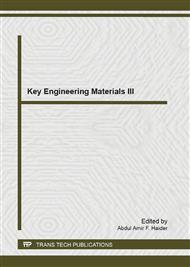[1]
S. Ahmad, K. Hoang, and S. D. Mahanti, Phys. Rev. Lett. 96, 056403 (2006); 96, 169907(E) (2006).
Google Scholar
[2]
D. Bilc, S. D. Mahanti, E. Quarez, K.-F. Hsu, R. Pcionek, and M. G. Kanatzidis, Phys. Rev. Lett. 93, 146403 (2004).
Google Scholar
[3]
S. D. Mahanti and D. Bilc, J. Phys.: Condens. Matter 16, S5277 (2004).
Google Scholar
[4]
S.H. Wei and A. Zunger, Phys. Rev. B 55, 13605 (1997).
Google Scholar
[5]
E.A. Albanesi, C.M.I. Okoye, C.O. Rodriguez, E.L.P.Y. Blanca, and A.G. Petukhov, Phys. Rev. B 61, 16589 (2000).
Google Scholar
[6]
S. Ahmad, S.D. Mahanti, K. Hoang, and M. G. Kanatzidis, Phys. Rev. B, 74 155205 (2006).
Google Scholar
[7]
C. M. I. Okoye, J. Phys.: Condens. Matter 14, 8625 (2002).
Google Scholar
[8]
P. J. Lin, W. Saslow and M. L. Cohen, Solid State Commun. 5, 893 (1967).
Google Scholar
[9]
F. Herman, R. L. Kortum, I. B. Ortenburger, and J. P. Van Dyke, J. Physique Coll. 29 (Suppl.) C4 62 (1968).
Google Scholar
[10]
S. Rabii, Phys. Rev. 182 821 (1969); S. Rabii, Bull. Am. Phys. Soc. 13 413 (1968).
Google Scholar
[11]
K. M. Rabe, and J. D. Joannopoulos, Phys. Rev. B 32 2302 (1985).
Google Scholar
[12]
D. J. Singh, Planewaves, Pseudopotentials, and the LAPW Method (Kluwer Academic, Boston, 1994).
Google Scholar
[13]
P. Blaha, K. Schwarz, G. K. H. Madsen, D. Kvasnicka, and J. Luitz, WIEN2k, An Augmented Plane Wave + Local Orbitals Program for Calculating Crystal Properties, edited by Karlheinz Schwarz (Technische Universitat Wien, Austria, 2001).
Google Scholar
[14]
J. P. Perdew, K. Burke, and M. Ernzerhof, Phys. Rev. Lett. 77, 3865 (1996).
Google Scholar
[15]
D. D. Koelling and B. Harmon, J. Phys. C 13, 6147 (1980).
Google Scholar
[16]
R. F. Bis, and J. R. Dixon, J. Appl. Phys. 40, 1919 (1969).
Google Scholar
[17]
L. Esaki, and P. J. Stiles, Phys. Rev. Lett. 16 1108 (1966); L. Esaki, J. Phys. Soc. Japan 21, 589 (1966); R. Tsu, W. E. Howard, L. and Esaki, Phys. Rev. 172, 779 (1968).
DOI: 10.1103/physrevlett.16.1108
Google Scholar
[18]
Y. Gelbstein, Z. Dashevsty, and M. P. Daviel, Physica B 363, 196 (2005).
Google Scholar
[19]
L. I. Ryabova and D. R. Khokhlov, JETP Lett. 80, 133 (2004).
Google Scholar
[20]
C. S. Lent, M. A. Bowen, J. D. Dow, R. S. Allgaiger, O. F. Sankey, and E. S. Ho, Solid State Commun. 61, 83 (1987).
Google Scholar
[21]
S A Nemov, Yu I Ravich, Physics-Uspekhi 41 (8) 735 (1998).
Google Scholar


